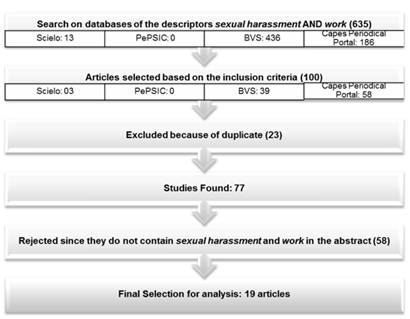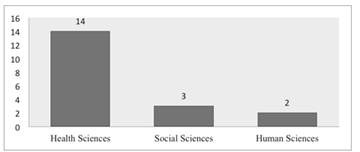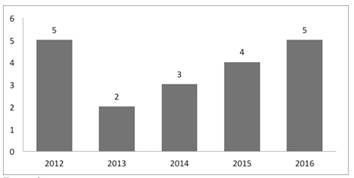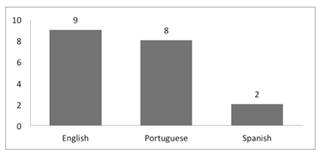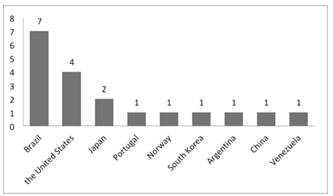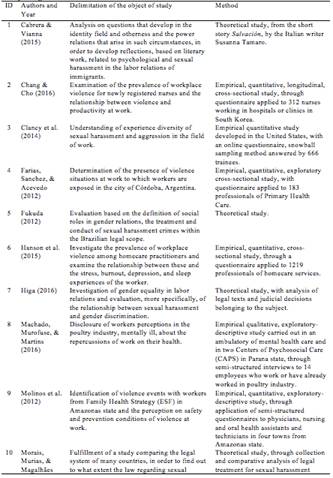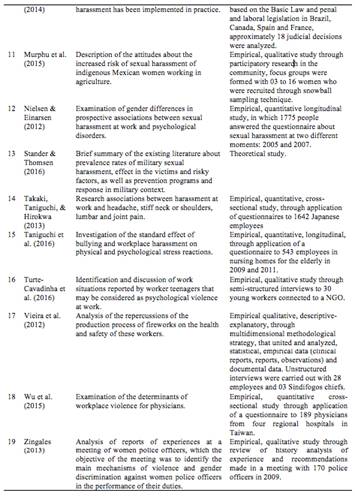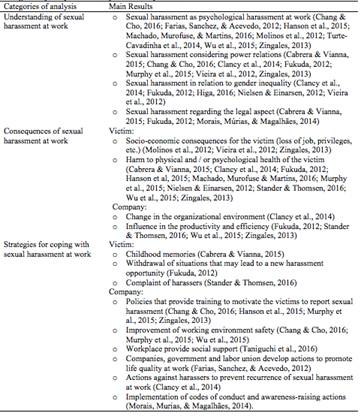Servicios Personalizados
Revista
Articulo
Links relacionados
Compartir
Ciencias Psicológicas
versión impresa ISSN 1688-4094versión On-line ISSN 1688-4221
Cienc. Psicol. vol.12 no.1 Montevideo mayo 2018
https://doi.org/10.22235/cp.v12i1.1592
Original Articles
Sexual Harassment at Work:A Systematic Review of Literature
1Programa de Pós-Graduação em Psicologia, Universidade Federal do Piauí. Brasil Correspondence: Programa de Pós-Graduação em Psicologia, Universidade Federal do Piauí; Brasil. Thaisa da Silva Fonseca: thaisafonseca23@hotmail.com; Ariane Viana Martins Portela: arianevmartins@gmail.com;Sandra Elisa de Assis Freire: sandraelisa.freire@gmail.com;Fauston Negreiros: faustonnegreiros@ufpi.br
Key words: sexual harassments work; consequences; coping strategies; systematic review
Palavras-chave: assédio sexual; trabalho; consequências; estratégias de enfrentamento; revisão sistemática
Palabras clave: acoso sexual; trabajo; consecuencias; estrategias de afrontamiento; revisión sistemática
Introduction
Sexual harassment at work has been subject of studies in several countries (Chang & Cho, 2016; Coutinho, 2015; Farias, Sanchez & Acevedo, 2012; Murphy, Samples, Morales & Shadbeh, 2015; Nielsen & Einarsen, 2012; Taniguchi, Takaki, Hirokawa, Fujii & Harano, 2016; Wu, Tung, Chen, Chen, Lin & Chen, 2015; Zingales, 2013).
For Higa, sexual harassment might be seen as discrimination when regarding gender. In addition, it violates the dignity of the individual who receives the action, taking away the person’s right of having a workplace where the health and balance can be assured. Dias (2008) defines sexual harassment as right infringement provided in the Brazilian Federal Constitution of 1988, being an action which was not intended by the victim and may cause an insult to her/his dignity and possible effects regarding the productivity and growth at work. For Ávila (2008), the sexual harassment might be mistaken in the literature with psychological harassment, but it differs because it is an action that involves, somehow, the possibility of sexual pleasure for the harasser and it may embarrass the assaulted one. For the author, not only the harassment involving the power and submission relationships between harasser and victim must be considered, but also the possibility of occurring between people of the same hierarchical level within the organization. Morais Filho (2009) states that for professionals working in the health field, the cases of sexual harassment from patients or care-givers are common, in manner that the cases of sexual harassment in working development can be observed by the quality reduction of professionals' work.
Such subject was firstly discussed in 1960s, in the American context with the term sexual harassment and became relevant and a question of interest for society since more women entered the labor market, attracting attention of feminist groups of women in face of the conduct. However, issues related to the sexual harassment suffered by workers in general are not always topics discussed within the organizations due to the complexity that the context represents. In many cases, the way the harassment occurs, without the presence of witnesses, makes strategies and prevention strategies difficult to be put into practice, facilitating the harassers’ impunity (Coutinho, 2015).
Women are quite affected by harassers, and, thus, the harassers proceed against them with machismo and sexual overtones. This makes the psychological harassment develops to sexual harassment (Caniato & Lima, 2008). However, although the literature refers sexual harassment to men being the harassers and women being the victims, any subject, regardless sexual orientation, may be harassed (Ministério do Trabalho e Emprego, 2013).
In the brochure Psychological and Sexual Harassment at Work (Cartilha Assédio Moral e Sexual no Trabalho) the Ministry of Labour and Employment -MTE (Ministério do Trabalho e Emprego-MTE) considers that the power relations resulting from the hierarchy in organizations influence the existence and maintenance of harassment, however, there must be evidence to support the victim in the complaint. Although it is important to know what the labor laws offer in order to protect the employee, the sexual harassment victims hesitate to report the harasser as they are afraid of being punished or losing their jobs (Turte, 2012).
Taking into consideration the argument presented, the need of this study is justified by the inexistence of a systematic review regarding the subject, as well as the need to verify how the subject is being searched and under which perspectives. This study aimed to carry out a systematic review of literature on sexual harassment at work, in order to analyze the investigations about this phenomenon and how it has been discussed.
Materials and Methods
This research is a systematic review of literature. Such study is regarded as secondary since it has the primary studies as data source (Galvão & Pereira, 2014) and it was based on the following steps: (a) delimitation of the problem to be researched; (b) choice of data sources; c) selection of descriptors for the search; (d) the pursuit and storage of results; (e) election of articles through abstract, according to the inclusion and exclusion criteria; (f) data extraction of selected articles; (g) assessment of the articles; and (h) data synthesis and interpretation (Costa & Zoltowski, 2014).
The research was conducted in the databases Scientific Electronic Library Online (SciELo), Portal of Electronic Journals of Psychology - PePSIC (Portal de Periódicos Eletrônicos de Psicologia - PePSIC), Virtual Health Library - VHL (Biblioteca Virtual em Saúde - BVS and Capes Periodical Portal (Portal Capes de Periódicos, accessed in June, 2017. SciElo is an electronic library which comprises various articles. PePSIC is a Virtual Health Library source for the Psychology area and it includes publications Latin American countries. BVS is a network that broadens access to scientific and technical health information in Latin America and the Caribbean. The Capes Periodical Portal is a virtual library that offers access to articles of national and international periodicals.
The consultation to the four databases were made at Universidade Federal do Piaui - Campus Ministro Reis Veloso, and Federal, with the aim to access the contracted content, allowing the inclusion of a wider number of articles to the present study. As search strategy, we used the Portuguese terms for sexual harassment AND work (assédio sexual AND trabalho); the inclusion criteria: (a) articles; (b) fully available; (c) Portuguese, English or Spanish Language; and (d) published in the period between 2012-2016; and the exclusion criteria: (a) duplicate and (b) not having sexual harassment and work in the abstract.
At first, 635 articles were found from the keywords, 100 were selected because they attended the inclusion criteria, 23 were rejected due to duplicate and 58 were excluded because the terms sexual harassment and work were not present in the abstract. Therefore, 19 articles were chosen for analyses, as shown in Figure 1. The information obtained was compiled into a database for categorization, through content analysis (Bardin, 2011).
Results
The 19 studies selected for analysis were classified in accordance with the general characterization of studies (subject area of periodical, year of study, language of study, country of origin of study), study design (delimitation of the subject of study and method used), and the categories of analysis obtained from the study results (understanding sexual harassment at work, consequences of sexual harassment at work, and strategies for coping with sexual harassment at work).
In relation to the subject area of the journals, there was a predominance of publications in journals of Health Science area, followed by Applied Social Sciences and Human Sciences, as presented in Figure 2.
With regard to the year of publication, in the period between 2012 to 2016, the years 2012 and 2016 had the largest number of publications and 2013 had the lowest one, as seen in Figure 3.
Concerning the language of studies publication, there was predominance of English and Portuguese languages when compared with Spanish language, as presented in Figure 4.
There was also diversity in the origin country of studies, with prevalence of Brazil as the country with the highest number of publications, followed by the United States, Japan and, then, the other countries as Portugal, Norway, South Korea, Argentina, China and Venezuela, according to Figure 5.
Considering delineation, shown in Table 1, Table 1 Continuation, there was a prevalence of empirical studies, when compared with theoretical studies. In empirical studies, the quantitative approach prevailed when compared with qualitative approach. As for the data collection instruments, questionnaires stood out, followed by interviews, focus groups and experience reports. All the empirical studies had employees as attendee in the investigation. Their occupations were diverse and varied in: trainees, healthcare professionals (physicians, nurses, dental surgeons, nursing and oral health assistants and technicians, community health agents, etc.), professionals of poultry industry, women farmers, professionals of production area of fireworks, police officers, and others.
From the studies’ subject, three categories were obtained for the analysis: 1) Understanding of sexual harassment at work; 2) Consequences of sexual harassment at work; and 3) Strategies of coping with sexual harassment at work, shown in Table 2.
1) Understanding of sexual harassment at work. This category included 16 studies that address the understanding of sexual harassment from four perspectives: sexual harassment as psychological violence at work (08 articles); sexual harassment from power relations (07 articles); sexual harassment from gender inequality (05 articles); and sexual harassment from legal aspects (03 articles), some articles comprise more than one understanding perspective.
2) Consequences of sexual harassment at work. In this category, 12 studies clarify the consequences of sexual harassment at work for the victim (12 articles) and for the company (05 articles). In relation to the victims, socio-economic consequences and harm to physical and psychological health were observed; regarding the company, changes in the organizational environment and influences in the productivity and efficiency. Some studies refer to both consequences simultaneously.
3) Strategies of coping with sexual harassment at work. This category included 11 studies which mentioned strategies made by the victim (03 articles) and by the companies (08 articles) regarding coping with sexual harassment at work. As strategies developed by the victims, it is possible to mention childhood memories, withdrawal of situations that may lead to a new harassment opportunity and complaint of harassers. As the strategies made by the companies, it is possible to mention the incentive policies for the complaints, improvement of the encouraging for the incentive policies, improvement of working environment safety, providing social support at working environment, actions to promote quality of life at work, implementation of codes of conduct and awareness actions.
Discussion
Although the subject sexual harassment a work is interest to different areas of knowledge, it has been noticed the predominance of publications in periodicals in the Health Sciences area, as well the reduction in the number of publications in 2012 and 2013, followed by a successive increase until the year 2016. However, an incipience in the number of studies regarding the subject is observed, mainly in the last years, and this may be supported by the 635 articles found in the initial search and by the selection of only 19 articles for analysis, even using four databases for the research (see Figure 1).
Most of the studies were published in a foreign language, mainly English. There is a noticeable diversity of country origin of the studies: Brazil, the United States, Japan, Portugal, Norway, South Korea, Argentina, China and Venezuela. However, in this study, Brazil stood out, followed by the United States, a country in which discussions on the subject began in the 1960s, according to Coutinho (2015). It is important to mention as a limitation that this study did not use only international databases, which may have reflected, along with the inclusion criteria adopted, in the results found.
With regard to the design of the studies, there is prevalence of empirical studies (Chang & Cho, 2016; Clancy Nelson, Rutherford & Hinde, 2014; Farias, Sanchez & Acevedo, 2012; Hanson, Perrin, Moss, Laharnar & Glass, 2015; Machado, Murofuse & Martins, 2016; Molinos, Coelho, Pires & Lindner, 2012; Murphy et al., 2015; Nielsen & Einarsen, 2012; Takaki, Taniguchi & Hirokwa, 2013; Taniguchi et al., 2016; Turte-Cavadinha, Turte-Cavadinha, Luz & Fisher, 2014; Vieira, Oliveira, Silva & Couto, 2012; Wu et al., 2015; Zingales, 2013), being mostly of quantitative approach and using questionnaire as data collection instrument (Chang & Cho, 2016; Clancy et al., 2014; Farias, Sanchez & Acevedo, 2012; Hanson et al., 2015; Molinos et al., 2012; Nielsen & Einarsen, 2012; Takaki, Taniguchi & Hirokwa, 2013; Taniguchi et al., 2016; Wu et al., 2015). Every participant of empirical, quantitative and qualitative studies were employees, due to the characteristic of the study subject, having different areas of practice.
In most of the analyzed studies, sexual harassment at work arises as a result of researches that set the work violence as the object of study (see Table 1). Therefore, one of the understandings of sexual harassment at work adopted is as being a type of sexual violence at work. (Chang & Cho, 2016; Farias, Sanchez & Acevedo, 2012; Hanson et al., 2015; Machado, Murofuse & Martins, 2016; Molinos et al., 2012; Turte-Cavadinha et al., 2014, Wu et al., 2015; Zingales, 2013). For that matter, it is necessary to carry out studies focused on sexual harassment at work as the main research target.
Another understanding of this subject is for the result of power relations, especially at hierarchy levels in the companies (Cabrera & Vianna, 2015; Chang & Cho, 2016; Clancy et al., 2014; Fukuda, 2012; Murphy et al., 2015; Vieira et al., 2012, Zingales, 2013), where few victims report their harassers (Stander & Thomsen, 2016), since the sexual harassment implies socio-economic consequences for the victim, as loss of job, for example (Molinos et al., 2012; Vieira et al., 2012; Zingales, 2013), similar to that suggested by Turte Study (2011).
Sexual harassment is also understood as arising from gender inequality (Clancy et al., 2014; Fukuda, 2012; Higa, 2016; Nielsen & Einarsen, 2012; Vieira et al., 2012). Most studies analyzed, even the ones which do not consider gender inequality as a way for understanding this phenomenon, considers that women as well as man can be victims and harassers (Cabrera & Vianna, 2015; Clancy et al., 2012; Fukuda, 2012; Higa, 2016; Morais, Murias & Magalhães, 2014; Nielsen & Einarsen, 2012; Stander e Thomsen, 2016; Turte-Cavadinha et al., 2014), as presented by MTE (2013). However, studies point out the woman as the main example of victim (Cabrera & Vianna, 2015; Clancy et al., 2014; Fukuda, 2012; Murphy et al., 2015; Molinos et al., 2012; Nielsen & Einarsen, 2012; Vieira et al., 2012; Zingales, 2013) and the man as the main example of harasser (Cabrera & Vianna, 2015; Fukuda, 2012).
The legal aspects are also used to understand the sexual harassment at work (Cabrera & Vianna, 2015; Fukuda, 2012; Morais, Múrias & Magalhães, 2014), including studies comparing the legislation of several countries, such as one that has resulted in countries such as Brazil, Canada, Spain, France and Portugal enshrining the presumption of innocence of the individual (Morais, Murias & Magalhães, 2014). This may be related to the difficulty of reporting sexual harassment by the victim, since the burden proof is needed as Coutinho (2015) also points out. These countries, with the exception of Portugal, criminalize sexual harassment at work, and Canada and Spain oblige the adoption of codes of conduct. All studies that adopt this perspective of understanding were theoretical.
It is important to mention that sexual harassment at work does not only occur in vertical relationships, but also in horizontal relationships, as from patients, colleagues, etc. (Chang & Cho, 2016; Farias, Sanchez & Acevedo, 2012; Molinos et al., 2012; Turte-Cavadinha et al., 2014), these results are ub accordance with the studies of Ávila (2008) and Morais Filho (2009).
The consequences of sexual harassment at work are diverse, affecting mainly the victim, through socio-economic consequences, such as loss of employment and heal to physical and / or psychological health. (Cabrera & Vianna, 2015; Clancy et al., 2014; Fukuda, 2012; Hanson et al., 2015; Machado, Murofuse & Martins, 2016; Molinos et al., 2012; Murphy et al., 2015; Nielsen & Einarsen, 2012; Stander & Thomsen, 2016; Wu et al., 2015; Zingales, 2013) as well as the companies, by changes in the organizational environment and interference in the productivity and efficiency (Clancy et al., 2014; Fukuda, 2012; Stander & Thomsen, 2016; Wu et al, 2015; Zingales, 2013).
As strategies for coping with sexual harassment at work, the victims have tried to escape from their harasser, through childhood memories and withdrawal of situations that may lead to another harassment; and, more rarely, the report of the harassers (Cabrera & Vianna, 2015; Fukuda, 2012; Stander & Thomsen, 2016); and those prompted by the companies, as encouraging complaints of sexual harassment, improvement of the safety at work environment, offering social support at work environment, actions of life quality at work; actions along with the harasser in order to avoid recurrence of sexual harassment at work; the implementation of codes of conduct and awareness actions, for instance (Chang & Cho, 2016; Clancy et al., 2014; Farias, Sanchez & Acevedo, 2012; Hanson et al., 2015; Morais, Murias & Magalhães, 2014; Murphy et al., 2015; Zingales, 2013; Taniguchi et al., 2016; Wu et al., 2015).
The studies which adopted more than one comprehension of sexual harassment at work, as for example, the studies that comprise sexual harassment as psychological violence at work and from relations of power (Chang & Cho, 2016; Zingales, 2013); from relations of power and gender inequality (Cabrera & Vianna, 2015; Clancy et al., 2014; Vieira et al., 2012); and from relations of power, gender inequality and legal aspects (Fukuda, 2012).
Conclusion
Sexual harassment at work is a subject of interest in several areas of knowledge and has been under discussion worldwide from different approaches. This study aimed to carry out a systematic review of scientific production regarding sexual harassment at work, intending to analyze the investigations about this phenomenon and how it has been discussed in the last five years.
The relevance of this research lies in the lack of a systematic review around the subject in focus in the period contemplated, and it is important to discuss it through a process of systematization and critical evaluation of several recent studies and according to pre-determined inclusion and exclusion criteria. The search in four databases allowed to verify an incipience in the number of recent studies that focus the relation between sexual harassment and work as a target of investigation, which reflects in the reduced number of studies analyzed when compared with the quantity of studies obtained initially through the search with descriptors in Portuguese.
It is possible to notice that although in this research Brazil prevailed as the country of studies origin, the main language of publication was English, which suggests an internationalization of Brazilian scientific production. The study design was mainly of empirical nature, quantitative approach and using questionnaires as instruments of data collection. Most of the theoretical studies covered documental research, with legislation as data source.
The analysis of the studies made possible the understanding of sexual harassment at work from four perspectives: sexual harassment at work as a type of psychological violence at work; sexual harassment at work comprised of power relations; sexual harassment at work comprised of gender inequality; and sexual harassment at work comprised of the legal point of view. It is noticed that some studies adopt more than a focus of understanding the theme. It was also possible to identify the consequences of sexual harassment at work for the victim and for companies; and strategies for coping with sexual harassment at work, promoted by victims and by organizations.
The systematic review of the literature has provided an overview of the discussion of sexual harassment at work in the last five years, in order to overcome the lack of this kind of study and achieve the initial goal. However, it is suggested both the increase in the number of theoretical and empirical studies on the subject, as well as a systematic review covering a larger number of databases, mainly international ones, or extending the period of publication.
How to cite this article:
Fonseca, T. D., Portela, A. M., Freire, S. D., & Negreiros, F. (2018). Assédio Sexual no Trabalho: Uma Revisão Sistemática de Literatura.Ciencias Psicológicas,12(1), 25-34. doi: 10.22235/cp.v12i1.1592
Referências
Ávila, R. P. (2008). As consequências do assédio moral no ambiente de trabalho. (Dissertação de Mestrado, Universidade de Caxias do Sul, RS). Accessed on: http://www.dominiopublico.gov.br/download/teste/arqs/cp067933.pdf [ Links ]
Bardin, L. (2011). Análise de Conteúdo. São Paulo, SP: Edições 70. [ Links ]
Cabrera, A. P. & Vianna, V. L. L (2015). Literatura e direitos humanos: questões sobre alteridade e identidade. Revista Letras & Letras, 31(1). Accessed on: http://www.seer.ufu.br/index.php/letraseletras/article/view/28878 [ Links ]
Caniato, A. M. P. & Lima, E. C. (2008). Assédio moral nas organizações de trabalho: perversão e sofrimento.Cadernos de Psicologia Social do Trabalho , 11(2), 177-192. Accessed on: http://pepsic.bvsalud.org/scielo.php?script=sci_arttext&pid=S1516-37172008000200004&lng=pt&tlng=pt. [ Links ]
Chang, H. E. & Cho, S. H. (2016). Workplace Violence and Job Outcomes of Newly Licensed Nurses. Asian Nursing Research, 10, 271-276, doi: 10.1016/j.anr.2016.09.001. [ Links ]
Clancy, K. B. H.; Nelson, R. G.; Rutherford, J. N., & Hinde, K. (2014). Survey of Academic Field Experiences (SAFE). Trainees Report Harassment and Assault, 9(7), 1-9. Accessed on: http://journals.plos.org/plosone/article?id=10.1371/journal.pone.0102172 [ Links ]
Coutinho, C. M. (2015). O assédio sexual nas relações trabalhistas: suas incidências e perspectivas. (Trabalho de Conclusão de Curso, Universidade Tuiuti do Paraná, PR). Accessed on: http://tcconline.utp.br/media/tcc/2015/09/O-ASSEDIO-SEXUAL-NAS-RELACOES-TRABALHISTAS-SUAS-INCIDENCIAS-E-PERSPECTIVAS.pdf [ Links ]
Costa, A. B. & Zoltowski, A. P. C. (2014). Como escrever um artigo de revisão sistemática. In Koller, M. C. P. P. C. & Hohendorff, J. V. (Org.), Manual de produção científica, 55-70. Porto Alegre, RS: Penso. [ Links ]
Dias, I. (2008). Violência contra as mulheres no trabalho: O caso do assédio sexual.Sociologia, Problemas e Práticas, 57, 11-23. Accessed on: http://www.scielo.mec.pt/scielo.php?script=sci_arttext&pid=S0873-65292008000200002&lng=pt&tlng=pt. [ Links ]
Farias, A.; Sanchez, J., & Acevedo, G. (2012). La violencia ocupacional en centros de atención primaria de la salud. Revista de Salud Pública, 16(1), 18-26. Accessed on: http://revistas-est.unc.edu.ar/index.php/rsp/article/view/126 [ Links ]
Fukuda, R. F. (2012). Assédio sexual: uma releitura a partir de relações de gênero. Revista Simbiótica. Accessed on: http://periodicos.ufes.br/simbiotica/article/view/4512 [ Links ]
Galvão, T. F. & Pereira, M. G. (2014, jan./mar.). Revisões sistemática da literatura: passos para sua elaboração. Epidemiologia e Serviços de Saúde, 23(1), 183-184. doi: 10.5123/S1679-49742014000100018 [ Links ]
Hanson, G. C.; Perrin, N. A., Moss, H., Laharnar, N., & Glass, N. (2015). Workplace violence against homecare workers and its relationship with workers health outcomes: a cross-sectional study. BMC Public Health,15, 1-13, doi: 10.1186/s12889-014-1340-7. [ Links ]
Higa, F. C. (2016). Assédio sexual no trabalho e discriminação de gênero: duas faces da mesma moeda?, Revista Direito GV, 12(2), 484-515, doi: 10.1590/2317-6172201620. [ Links ]
Machado, L. F.; Murofuse, N. T., & Martins, J. T. (2016). Vivências de ser trabalhador na agroindústria avícola dos usuários de atenção à saúde mental. Revista Saúde Debate, 40(110), 134-147, doi: 10.1590/0103-1104201611010. [ Links ]
Ministério do Trabalho e Emprego (2013). Cartilha elaborada pela Subcomissão de Gênero com participação da Comissão de Ética do MTE. Assédio moral, trabalho, Brasil. 2. Assédio sexual, trabalho, Brasil. Assessoria de Comunicação (ASCOM). Brasília; Ministério do Trabalho e Emprego, 41. [ Links ]
Molinos, B. G., Coelho, E. B. S., Pires, R. O. M., & Lindner, S. R. (2012). Violência com profissionais da Atenção Básica: estudo no interior da Amazônia Brasileira. Cogitare Enfermagem, 17(2), 239-247. doi: http://dx.doi.org/10.5380/ce.v17i2.25747. [ Links ]
Morais Filho, L. A. (2009). Violência ocupacional contra profissionais de saúde em um hospital de urgência, Natal-RN. (Dissertação de Mestrado, Universidade Federal do Rio Grande do Norte, RN). Accessed on: https://repositorio.ufrn.br/jspui/bitstream/123456789/14685/1/LuisAMF_DISSERT.pdf [ Links ]
Morais, T.; Múrias, C., & Magalhães, M. J. (2009). Assédio sexual no trabalho: uma reflexão a partir de ordenamentos jurídicos. International Journal on Working Conditions. Accessed on: https://sigarra.up.pt/flup/pt/pub_geral.pub_view?pi_pub_base_id=92563 [ Links ]
Murphy, J.; Samples, J.; Morales, M., & Shadbeh, N. (2015). They Talk Like That, But We Keep Working: Sexual Harassment and Sexual Assault Experiences Among Mexican Indigenous Farmworker Women in Oregon. Journal of immigrant and minority health, 17(6), 1834-1839. doi: 10.1007/s10903-014-9992-z. [ Links ]
Nielsen, M. B. & Einarsen, S. (2012). Prospective relationships between workplace sexual harassment and psychological distress. Occupational Medicine, 62(3), 226-228. doi: 10.1093/occmed/kqs010. [ Links ]
Stander, V. A. & Thomsen, C. J. (2016). Sexual harassment and assault in the U.S. Military: a review of policy and research trends. Military Medicine, 181(1), 20-27. doi: 10.7205/MILMED-D-15-00336. [ Links ]
Taniguchi, T., Takaki, J., Hirokawa, K., Fujii, Y., & Harano, K. (2016). Associations of workplace bullying and harassment with stress reactions: a two-year follow-up study. Industrial Health, 54(2), 131-138. doi: 10.2486/indhealth.2014-0206. [ Links ]
Takaki, J.; Taniguchi, T., & Hirokawa, K. (2013). Associations of Workplace Bullying and Harassment with Pain. International journal of environmental research and public health, 10(10), 4560-4570. doi: 10.3390/ijerph10104560. [ Links ]
Turte, S. L. (2011). Violência psicológica e assédio moral no trabalho: percepção de estratégias de enfrentamento de adolescentes trabalhadores. (Dissertação de Mestrado, Faculdade de Saúde Pública, Universidade de São Paulo, São Paulo). doi: 10.11606/D.6.2012.tde-29012012-170212. [ Links ]
Turte-Cavadinha, S. L., Turte-Cavadinha, E., Luz, A. A., & Fisher, F. M. (2014). A violência psicológica no trabalho discutida a partir de vivências de adolescentes trabalhadores. Revista Brasileira de Saúde Ocupacional, 39(130), 210-223. doi: 10.1590/0303-7657000084513. [ Links ]
Vieira, C. E. C.; Oliveira, A. C.; Silva, I. A., & Couto, R. I (2012). Os bastidores da produção de fogos de artifício em Santo Antônio do Monte: degradação das condições de trabalho e saúde dos pirotecnistas. Cadernos de Psicologia Social do Trabalho , 15 (1), 135-152. Accessed on: https://www.researchgate.net/publication/271586448_Os_bastidores_da_producao_de_fogos_de_artificio_em_Santo_Antonio_do_Monte_degradacao_das_condicoes_de_trabalho_e_saude_dos_pirotecnistas [ Links ]
Wu, J. C., Tung, T.H., Chen, P.Y., Chen, Y.L., Lin, Y.W., & Chen, F.L. (2015). Determinants of workplace violence against clinical physicians in hospitals. J Occup Health, 57(6):540-547, doi: 10.1539/joh.15-0111-AO. [ Links ]
Zingales, R. (2013). Vivencia del acoso sexual en el trabajo, afrontamiento y respuesta institucional. Caso funcionarias policiales en Venezuela. Salud trab. (Maracay), 21(1), 41-55. Accessed on: http://bases.bireme.br/cgi-bin/wxislind.exe/iah/online/?IsisScript=iah/iah.xis& base=LILACS&lang=p&nextAction=lnk&exprSearch=714911&indexSearch=ID [ Links ]
Received: July 15, 2017; Revised: December 18, 2017; Accepted: February 12, 2018











 texto en
texto en 

